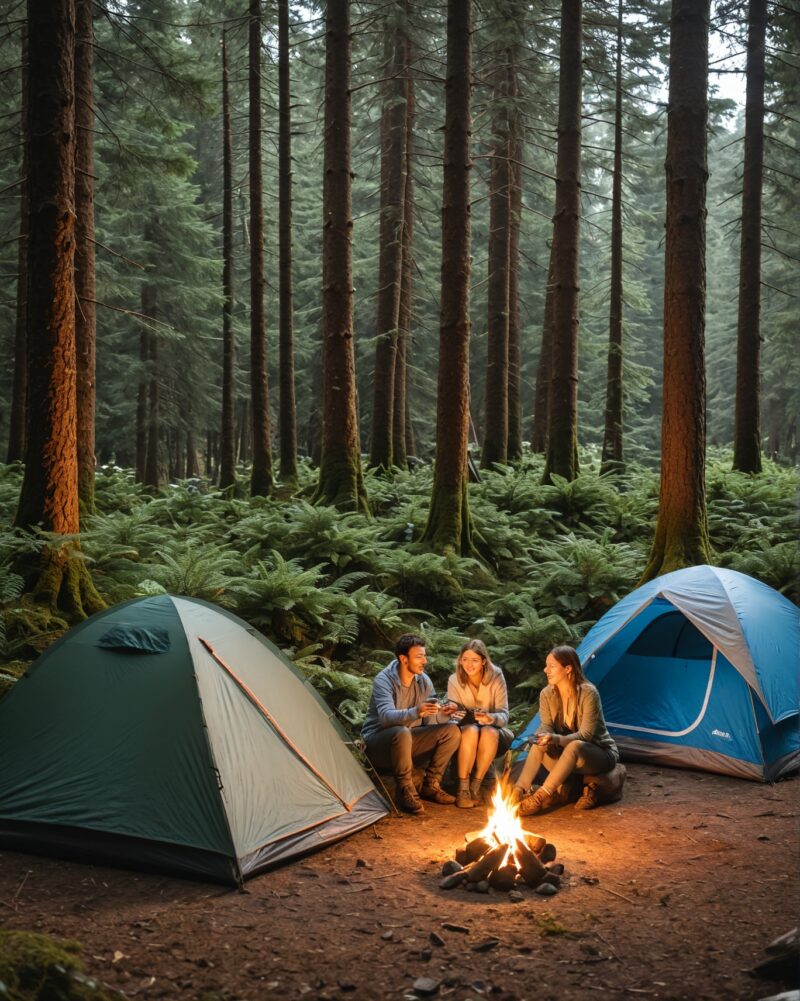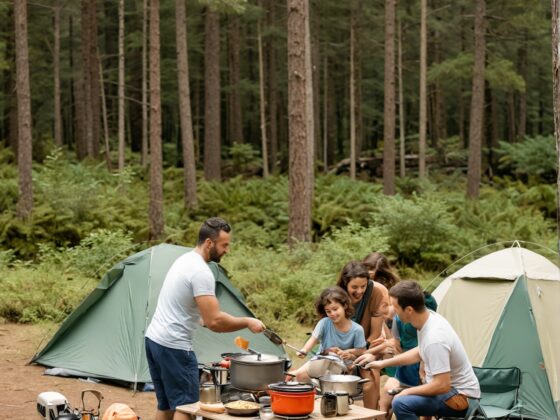The Philippines is a country rich in history, culture, and natural beauty. From the majestic Banaue Rice Terraces to the awe-inspiring Chocolate Hills, the archipelago is home to a plethora of iconic landmarks that have captivated visitors from around the world. For those seeking to immerse themselves in the country’s heritage, exploring these sites through historical camping offers a unique and unforgettable experience.
By setting up camp amidst these historic locales, travelers can not only marvel at the architectural and natural wonders but also gain a deeper understanding of the cultural significance that lies within. Whether it’s the Spanish colonial influence in the walled city of Intramuros or the ancient traditions of indigenous tribes in the remote highlands, the Philippines’ historical sites offer a window into the nation’s rich past.
Embarking on a historical camping adventure allows adventurers to truly connect with the spirit of these iconic landmarks, fostering a greater appreciation for the country’s heritage and the importance of preserving it for future generations.
Camping at Historical Sites
Camping at historical sites in the Philippines presents a unique opportunity to immerse oneself in the country’s past while enjoying the great outdoors. From the tranquil shores of Siargao Island to the rugged terrain of the Cordillera Mountains, there are numerous destinations where travelers can set up camp amidst the remnants of ancient civilizations and colonial-era structures.
One of the key benefits of historical camping is the chance to experience these sites in a more intimate and immersive manner. Rather than simply passing through as a day-tripper, campers can linger and soak in the atmosphere, engaging with the local community and learning about the site’s history and cultural significance.
Moreover, camping at historical sites often provides access to areas that are off-limits to regular visitors, allowing for a more exclusive and authentic experience. This can include exploring hidden trails, visiting restricted archaeological sites, or participating in traditional cultural activities with the local inhabitants.
By combining the adventure of camping with the rich history and cultural heritage of the Philippines, historical camping offers a truly unique and unforgettable way to explore the country’s most iconic landmarks.
Safety Tips for Historical Camping
Embarking on a historical camping adventure in the Philippines requires careful planning and preparation to ensure a safe and enjoyable experience. Here are some essential safety tips to keep in mind:
- Research the Site: Before setting out, thoroughly research the historical site and its surrounding area to identify any potential hazards or restrictions. Consult with local authorities or tourism boards to understand the site’s rules and regulations.
- Obtain Permits: Many historical sites in the Philippines require permits or advance permission for camping. Ensure that all necessary paperwork is in order before your trip.
- Pack Appropriate Gear: Invest in high-quality camping equipment, including a sturdy tent, sleeping bags, and weatherproof clothing. Additionally, bring a first-aid kit and any necessary medications.
- Respect the Environment: Always practice Leave No Trace principles, ensuring that your campsite is left in the same condition (or better) as when you arrived. Dispose of waste properly and minimize your impact on the surrounding ecosystem.
- Familiarize Yourself with the Site: Upon arrival, take the time to explore the historical site and familiarize yourself with the layout, potential hazards, and any designated camping areas.
- Engage with the Local Community: Interact with the local community and seek their guidance on the site’s history, cultural traditions, and any safety considerations.
- Stay Vigilant: Remain alert and aware of your surroundings at all times, particularly during nighttime hours. Follow any safety protocols or instructions provided by the site’s caretakers or local authorities.
By adhering to these safety tips, adventurers can ensure a memorable and responsible historical camping experience in the Philippines.
What to Pack for a Historical Camping Adventure
Preparing for a historical camping adventure in the Philippines requires a thoughtful and comprehensive packing list. Coleman Philippines has a wide array of camping essentials. But beyond the essentials for any camping trip, there are several additional items that can enhance the experience and ensure your comfort while exploring the country’s iconic landmarks.
- Camping Gear:
- High-quality, weatherproof tent
- Sleeping bag and pad
- Portable stove and fuel
- Cookware and utensils
- Water purification system
- Flashlight or headlamp
- Multi-tool or Swiss Army knife
- Clothing and Footwear:
- Moisture-wicking base layers
- Insulating mid-layers
- Weatherproof outer layers
- Sturdy, well-broken-in hiking boots
- Comfortable, closed-toe shoes for exploring
- Sun protection (hat, sunglasses, sunscreen)
- Documentation and Electronics:
- Passport and/or ID
- Copies of permits and reservations
- Portable power bank
- Camera and extra batteries
- Binoculars (for wildlife viewing)
- Compass and/or GPS device
- Personal Care:
- First-aid kit
- Toiletries (toothbrush, biodegradable soap, etc.)
- Insect repellent
- Medications (if applicable)
- Cultural Appreciation:
- Guidebooks or informational materials about the site
- Notebook and pen for journaling
- Small gifts or tokens to share with local communities
By packing the right gear and supplies, adventurers can ensure a comfortable and enriching historical camping experience in the Philippines, allowing them to fully immerse themselves in the country’s rich heritage.
Best Historical Camping Sites in the Philippines
The Philippines offers a diverse array of historical camping destinations, each with its own unique charms and cultural significance. Here are some of the best historical camping sites to explore:
- Banaue Rice Terraces, Ifugao:
- Explore the ancient rice terraces, a UNESCO World Heritage Site
- Camp amidst the stunning Cordillera Mountain scenery
- Engage with the local Ifugao community and learn about their traditional way of life
- Intramuros, Manila:
- Camp within the walls of the historic walled city, a remnant of the Spanish colonial era
- Discover the iconic landmarks, such as Fort Santiago and the Manila Cathedral
- Immerse yourself in the vibrant culture and rich history of the capital city
- Siargao Island, Surigao del Norte:
- Camp on the pristine beaches and witness the island’s natural beauty
- Explore the ancient rock formations and caves, remnants of the island’s geological past
- Engage with the local Visayan culture and learn about their maritime traditions
- Chocolate Hills, Bohol:
- Camp amidst the unique geological formations, a natural wonder of the Philippines
- Discover the ancient legends and indigenous beliefs associated with the Chocolate Hills
- Venture into the nearby forests and rivers to experience the island’s diverse ecosystems
- Tabon Caves, Palawan:
- Camp within the ancient Tabon Caves, a significant archaeological site
- Explore the cave system and learn about the early human habitation in the region
- Immerse yourself in the natural beauty of Palawan, known as the “Last Frontier”
By choosing from these and other historical camping destinations, adventurers can embark on a truly unique and enriching journey, connecting with the Philippines’ past while enjoying the great outdoors.
Conclusion: Preserving History through Historical Camping
Historical camping in the Philippines offers a remarkable opportunity to not only explore the country’s iconic landmarks but also to actively participate in the preservation of its rich cultural heritage. By immersing themselves in these historic sites and engaging with the local communities, adventurers can develop a deeper appreciation for the Philippines’ past and the importance of safeguarding it for future generations.
Through responsible and sustainable camping practices, historical campers can minimize their impact on the environment and demonstrate respect for the fragile ecosystems and cultural resources that these sites represent. By sharing their experiences and advocating for the protection of these heritage sites, they can inspire others to follow in their footsteps and contribute to the ongoing efforts to preserve the Philippines’ unique identity.


